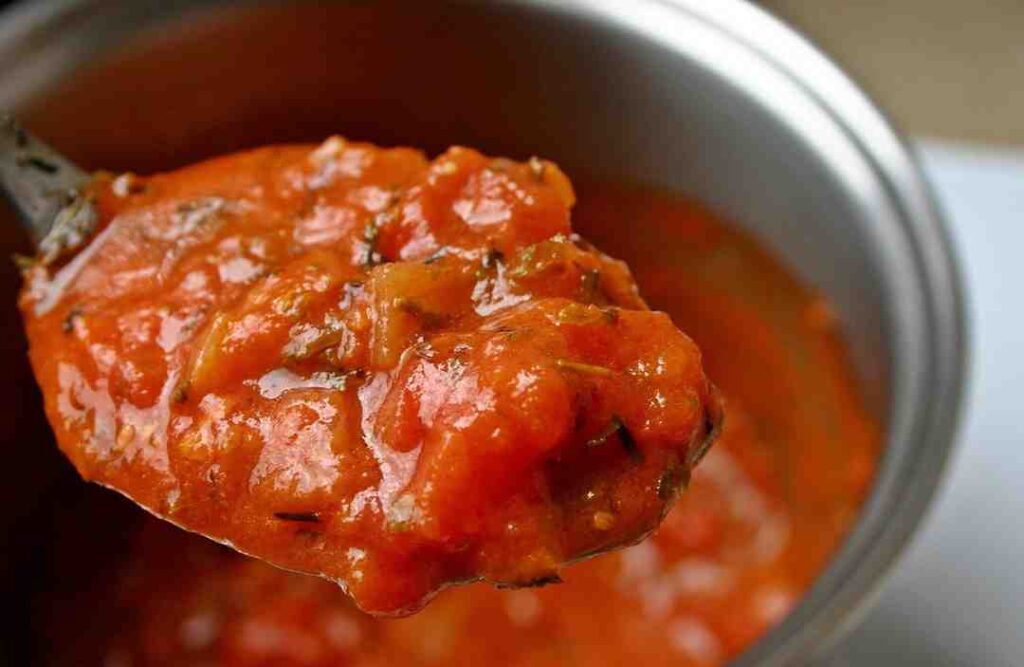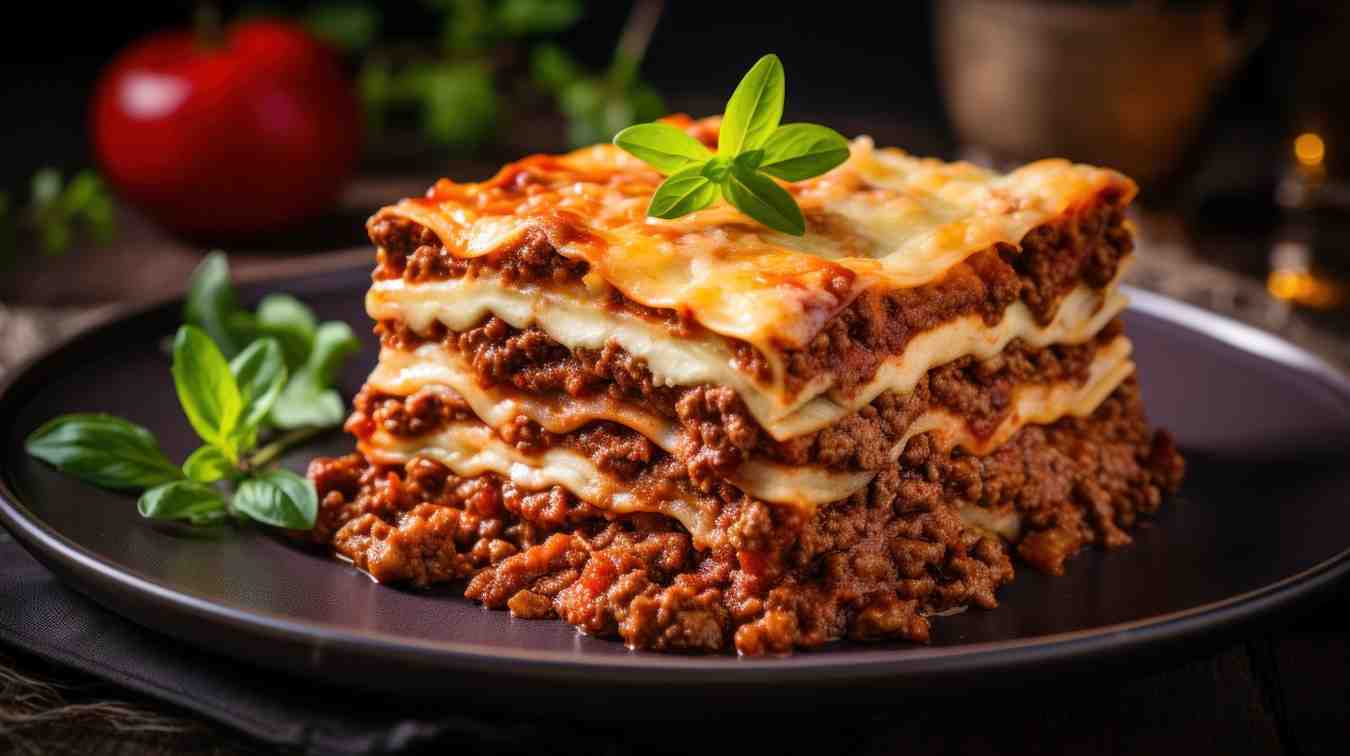A great lasagna sauce is the heart of the dish, blending rich flavors, moisture, and texture to elevate all the other components. The balance between sauces is crucial for ensuring that each bite is satisfying. Typically, lasagna relies on two types of sauces:
- Tomato-Based Sauce (Red Sauce): This sauce is the cornerstone of classic lasagna. Made from tomatoes, garlic, onions, and herbs like oregano and basil, the red sauce offers a tangy, slightly sweet base that complements the rich flavors of the meat and cheese. The acidity from the tomatoes also helps to cut through the heaviness of the dish, making it more balanced and palatable(All Roads Lead To Italy).
- Béchamel Sauce (White Sauce): Originating from French cuisine but commonly used in Italian lasagna, this creamy white sauce is made from a simple roux of butter, flour, and milk. It adds a silky, smooth texture and a mild, buttery flavor that balances the sharpness of the tomato sauce. The béchamel also serves as a binder that holds the layers of the lasagna together.
Combining both sauces ensures that your lasagna has the right balance of acidity, creaminess, and depth of flavor, which creates a well-rounded dish.

Ingredients for Lasagna Meat Sauce
To create a rich and flavorful lasagna meat sauce, you need high-quality ingredients. Here’s a breakdown of the essential components:
- Ground Beef and Italian Sausage: The combination of beef and sausage brings a robust, savory flavor to the sauce. Beef provides a hearty, meaty base, while the sausage introduces spiced, slightly sweet undertones. Some recipes use mild or sweet Italian sausage, but spicy sausage can also add an extra kick.
- Aromatics (Onions, Garlic, Celery): Onions and garlic are essential for building a flavorful base. Onions add a hint of sweetness, while garlic provides sharpness and depth. Adding celery and sometimes carrots to the mix introduces natural sweetness and balances the acidity of the tomatoes(.
- Tomato Components: For a rich and hearty sauce, use a mix of tomato paste, sauce, and whole tomatoes. The tomato paste intensifies the flavor, the sauce provides a smoother texture, and whole tomatoes add chunks for a more rustic feel.
- Herbs and Spices: Classic Italian herbs such as oregano, basil, and thyme are essential for seasoning the sauce. You can also add red pepper flakes for a slight heat or use fresh herbs for a brighter flavor.
Essential Add-Ins
Some recipes recommend adding additional ingredients to balance the flavor of the sauce:
- Sugar: A pinch of sugar helps balance the acidity of the tomatoes, making the sauce smoother and less tangy. This step is especially helpful if your tomatoes are very acidic.
- Vinegar: Adding a splash of r vinegar gives the sauce depth and complexity. Vinegar adds a sharp tang that balances the sweetness.
Vegetarian Alternatives
For a meatless lasagna, consider using mushrooms or plant-based meat alternatives. Mushrooms, such as portobellos, add a meaty texture and earthy flavor, making them an excellent substitute for ground beef. Alternatively, plant-based sausages or ground meat can be used to maintain a similar texture and taste without using animal products.
Step-by-Step Meat Sauce Recipe

Creating the perfect meat sauce for lasagna involves several steps, each of which builds layers of flavor:
- Brown the Meat: Begin by browning the ground beef and sausage in a large skillet. Browning the meat helps develop rich, caramelized flavors that form the foundation of the sauce. Ensure the meat is fully cooked and slightly crispy on the edges before moving on.
- Sauté Vegetables: After removing the meat, sauté onions, garlic, celery, and carrots in the same skillet. These vegetables add sweetness and depth to the sauce. Carrots are particularly useful for balancing out the natural acidity of the tomatoes.
- Simmer the Sauce: Once the vegetables are softened, add the tomato paste, sauce, and whole tomatoes. Simmer the sauce for at least 30 to 60 minutes, allowing the flavors to meld together. The longer the sauce simmers, the richer and more concentrated the flavors will become.
- Seasoning the Sauce: Add your herbs and spices while the sauce is simmering. Taste the sauce periodically and adjust the seasoning as necessary. If the sauce tastes too acidic, a pinch of sugar can help balance it out. For a richer flavor, consider adding a splash of red wine.
Pro Tips for Perfect Sauce
- Don’t Rush the Simmering Process: Allowing the sauce to simmer for a longer time will result in deeper, more developed flavors. Rushing this step will prevent the ingredients from blending together harmoniously.
- Adjust Seasonings as You Go: Tasting the sauce periodically and adjusting the seasonings ensures that the flavors are balanced. Add more salt, pepper, or herbs if necessary, and don’t hesitate to tweak the recipe to suit your taste.
Crafting a Perfect Béchamel Sauce
A béchamel sauce is essential for balancing the acidity and sharpness of the tomato-based meat sauce in lasagna. Its creamy, smooth texture adds a luxurious layer that elevates the dish, especially when combined with cheeses like mozzarella and Parmesan.
The béchamel is a classic French white sauce, and it’s surprisingly simple to make:
- Creating the Roux: The base of any béchamel is a roux, which is a mixture of butter and flour cooked together. Start by melting 2 tablespoons of butter over medium heat in a saucepan. Once the butter is fully melted, whisk in 2 tablespoons of flour. Keep whisking constantly to avoid lumps and cook for about 2 minutes until the flour has absorbed the butter and turns slightly golden.
- Adding Milk: Slowly pour in 2 cups of milk, whisking as you go. The gradual addition of milk ensures the sauce remains smooth without clumps. Continue whisking as the mixture thickens, which should take about 5-7 minutes. You’ll know it’s done when it coats the back of a spoon and runs off slowly.
- Seasoning: To finish your béchamel, season it with a pinch of salt, pepper, and freshly grated nutmeg. Nutmeg adds a subtle warmth and complexity to the sauce that pairs beautifully with the richness of the lasagna. Some recipes also suggest adding a dash of white pepper to maintain the sauce’s clean white appearance.
- Consistency: Béchamel should be creamy and smooth but not too thick or runny. If your sauce is too thick, whisk in a little more milk. If it’s too thin, let it cook a bit longer, whisking constantly to avoid burning at the bottom.
While homemade béchamel elevates your lasagna, you can opt for store-bought béchamel in a pinch. Just be mindful of the consistency and flavor, as it might be thinner and less seasoned than a homemade version.
How to Avoid Common Mistakes
- Prevent Lumps: The most common issue when making béchamel is lumps. To avoid this, whisk constantly while adding the milk, and make sure it’s added gradually. If you do end up with a lumpy sauce, strain it through a fine-mesh sieve or use an immersion blender to smooth it out.
- Consistency Control: Béchamel needs to be thick enough to provide body to the lasagna but still spreadable. If your sauce is too thick, thin it out with a bit more milk. If too runny, let it cook a few minutes longer, whisking as it thickens.
Layering Your Lasagna: Balancing Sauces and Cheese
Layering is where the magic of lasagna truly happens. This process is about achieving the right balance between the red meat sauce, béchamel, and cheese to ensure a flavorful and cohesive dish. Here’s a guide on how to layer your lasagna for optimal results:
- Start with the Sauces: Begin by spreading a thin layer of red sauce on the bottom of your baking dish. This helps prevent the pasta from sticking and keeps the lasagna moist. Follow with a thin layer of béchamel over the red sauce. This ensures every bite contains both creamy and tangy elements.
- Pasta Sheets: Place a layer of pasta sheets over the sauces. If you’re using fresh pasta, there’s no need to pre-boil them, but dried pasta sheets should be par-cooked until they’re al dente. Lay the pasta sheets slightly overlapping each other so they form a solid base.
- Cheese Layer: Spread a mixture of ricotta, mozzarella, and Parmesan evenly over the pasta. Ricotta provides creaminess, while mozzarella melts beautifully, and Parmesan adds a sharp, salty kick. This combination gives the lasagna its rich, gooey texture.
- Repeat the Layers: Continue layering the red sauce, béchamel, pasta, and cheese. Typically, lasagna has three to four layers, depending on the depth of your baking dish. Ensure each layer has enough sauce to keep the lasagna moist and avoid dry spots.
- Top Layer: For the final layer, top with pasta sheets, a generous layer of red sauce, and a final sprinkling of mozzarella and Parmesan. You can also drizzle some remaining béchamel over the top for added creaminess.
Customizing with Extras
You can add extra flavor and nutrition to your lasagna by incorporating different vegetables or experimenting with fresh versus dried pasta:
- Adding Vegetables: Incorporate vegetables like spinach, zucchini, or bell peppers into your layers. Spinach adds a healthy, green layer, while zucchini or bell peppers introduce sweetness and a slight crunch.
- Fresh vs. Dried Pasta: Fresh pasta sheets have a tender, melt-in-your-mouth texture and require no pre-cooking, while dried pasta sheets offer a firmer bite but require boiling or par-boiling before use. Both options can work well, but fresh pasta tends to soak up the sauces more effectively.
Baking and Serving
The final step in making a lasagna is the baking, which brings all the flavors together and melts the cheese into a gooey, delicious topping.
- Oven Temperature: Preheat your oven to 350°F (175°C). Cover the lasagna with foil to prevent the top from burning and bake it for about 40-50 minutes. The foil ensures that the lasagna cooks evenly without drying out.
- Final Browning: Remove the foil during the last 10 minutes of baking to allow the top to brown and the cheese to crisp up. If you prefer a more golden top, you can broil it for an additional 2-3 minutes.
- Resting the Lasagna: After removing the lasagna from the oven, it’s important to let it rest for at least 15 minutes before serving. This allows the layers to set, making it easier to slice and preventing the fillings from spilling out. Resting also ensures that the flavors have time to meld together.
Top Tips for Creating the Perfect Lasagna Sauce
| Tip | Details |
|---|---|
| Use High-Quality Tomatoes | Opt for whole peeled or high-quality tomatoes like San Marzano for a richer flavor. Avoid overly acidic or watery varieties. |
| Balance Acidity with Sugar | If the tomatoes taste too acidic, add a pinch of sugar to balance the flavor without making the sauce too sweet. |
| Brown the Meat Well | Browning the meat thoroughly enhances the flavor by adding a rich, caramelized depth. Avoid skipping this step. |
| Simmer Slowly | Allow the sauce to simmer for at least 30-60 minutes. The longer it simmers, the more the flavors meld and develop. |
| Adjust the Seasoning | Taste the sauce as it cooks and adjust seasoning with salt, pepper, and herbs like oregano or basil to suit your taste. |
| Incorporate Vegetables | Adding carrots, celery, or bell peppers brings natural sweetness and depth to the sauce, balancing out the acidity. |
| Deglaze the Pan | After browning the meat, deglaze the pan with a splash of red wine or broth to capture all the flavorful browned bits. |
| Avoid Overcrowding the Pan | Browning meat in batches ensures even cooking. Overcrowding the pan can lead to steaming instead of browning. |
| Let the Sauce Rest | Let the sauce rest after cooking to thicken and allow the flavors to settle before layering it in the lasagna. |
| Don’t Forget Fresh Herbs | Add fresh herbs like basil or parsley at the end for a bright, fresh flavor that elevates the entire dish. |

